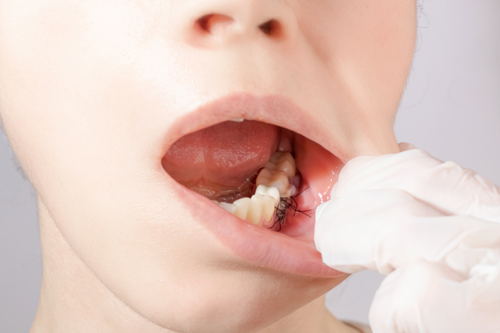
Gum disease can cause the gum line around your teeth to recede. Over time, your
gums may recede enough to expose the roots of your teeth. This also exposes nerves, which can cause discomfort.
Cold and hot foods and drinks, and even breathing cold air can be uncomfortable if your roots and nerves become exposed. Exposed roots can also elongate the tooth, giving you an older, less cosmetically appealing appearance. Additionally, some people have naturally thin gum tissue, which increases the chances for gum breakdown over time.
Gum grafting procedure works to rebuild gum tissue around your teeth and make necessary activities like eating and drinking more comfortable.
How is Gum Grafting Performed?
This treatment involves removing a small section of tissue from inside your mouth, or the roof of your mouth, and layering it over the damaged areas of gum. There are several types of gum grafts.
Connective Tissue Graft
The connective tissue graft is used when there is a large area of root exposure. The tissue is removed from the roof of the mouth and sutured onto the grafting site. The roof of the mouth offers a larger area from which to take donor tissue, especially important if larger areas require grafting.
Gingival Graft
If you have thin gum tissue, a gingival graft may be performed. There doesn’t need to be root or nerve exposure before your dentist can perform a gingival graft. A small piece of tissue is taken from the roof of your mouth and sutured to the thinning area of your gums. This can be performed to several thinning sites if needed. Over time, your gums will thicken and reduce the chance for exposed roots in the future.
Pedicle Graft
This graft is used if your gums have receded, but are otherwise healthy. A flap of tissue is cut, but left attached at one end, and is then moved sideways to cover exposed roots. This is an ideal graft, as the blood vessels remain in place.
After Care
It can take anywhere from one to two weeks for
your gum graft to properly heal. For the first two weeks after your procedure it’s recommended to avoid eating hard or hot foods that could aggravate the graft. Soft and cool foods, such as eggs, yogurt, cooked vegetables, and ice cream are recommended. You’ll also need to avoid brushing or flossing the area until it has healed. Using a mouthwash will help prevent any infections or plaque buildup that could cause issues with the graft. We may also recommend pain medication and request that you avoid exercise until you’ve healed.
Gum grafts are the most effective way to reduce further recession and bone loss, and protect the tooth roots from decay.
Dr. Kostirko and his team at
BloorWestSmiles Dental can explain and answer any other questions or concerns that you may have.
Give us a call to schedule your next appointment.
 Gum disease can cause the gum line around your teeth to recede. Over time, your gums may recede enough to expose the roots of your teeth. This also exposes nerves, which can cause discomfort.
Cold and hot foods and drinks, and even breathing cold air can be uncomfortable if your roots and nerves become exposed. Exposed roots can also elongate the tooth, giving you an older, less cosmetically appealing appearance. Additionally, some people have naturally thin gum tissue, which increases the chances for gum breakdown over time.
Gum grafting procedure works to rebuild gum tissue around your teeth and make necessary activities like eating and drinking more comfortable.
Gum disease can cause the gum line around your teeth to recede. Over time, your gums may recede enough to expose the roots of your teeth. This also exposes nerves, which can cause discomfort.
Cold and hot foods and drinks, and even breathing cold air can be uncomfortable if your roots and nerves become exposed. Exposed roots can also elongate the tooth, giving you an older, less cosmetically appealing appearance. Additionally, some people have naturally thin gum tissue, which increases the chances for gum breakdown over time.
Gum grafting procedure works to rebuild gum tissue around your teeth and make necessary activities like eating and drinking more comfortable.
 Gum disease can cause the gum line around your teeth to recede. Over time, your gums may recede enough to expose the roots of your teeth. This also exposes nerves, which can cause discomfort.
Cold and hot foods and drinks, and even breathing cold air can be uncomfortable if your roots and nerves become exposed. Exposed roots can also elongate the tooth, giving you an older, less cosmetically appealing appearance. Additionally, some people have naturally thin gum tissue, which increases the chances for gum breakdown over time.
Gum grafting procedure works to rebuild gum tissue around your teeth and make necessary activities like eating and drinking more comfortable.
Gum disease can cause the gum line around your teeth to recede. Over time, your gums may recede enough to expose the roots of your teeth. This also exposes nerves, which can cause discomfort.
Cold and hot foods and drinks, and even breathing cold air can be uncomfortable if your roots and nerves become exposed. Exposed roots can also elongate the tooth, giving you an older, less cosmetically appealing appearance. Additionally, some people have naturally thin gum tissue, which increases the chances for gum breakdown over time.
Gum grafting procedure works to rebuild gum tissue around your teeth and make necessary activities like eating and drinking more comfortable.
